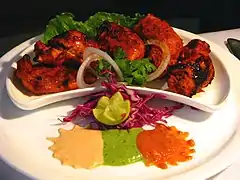Pakhala
Pakhaḷa (Odia: ପଖାଳ) is an Odia term for an Indian food consisting of cooked rice washed or lightly fermented in water. The liquid part is known as toraṇi.[1] It is popular in Odisha, West Bengal, Jharkhand, Assam, Chhattisgarh, and Tamil Nadu.
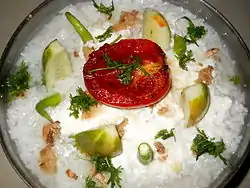 | |
| Course | Hot pakhaḷa, jira (cumin) pakhaḷa, basi (stale) rice, dhai (curd) pakhala |
|---|---|
| Place of origin | Indian subcontinent |
| Region or state | Odisha |
| Associated national cuisine | India |
| Serving temperature | Hot and cold |
| Main ingredients | Cooked rice |
| Variations | Panta bhat |
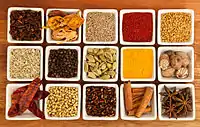 |
| This article is part of the series on |
| Indian cuisine |
|---|
|
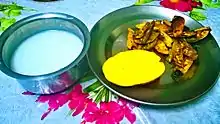
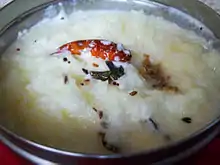
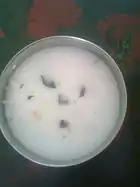
In Tamil Nadu it is called Pazhaiya Sadam. The Bengali name for this dish is panta bhat, in Chhattisgarh it's called bore bhat,[2] in Jharkhand linguistic communities use names like paani bhat, paakhaal or pakhala, and in Assam it's called poita bhat.[3]
It is a preparation that is had during summer, although many families and communities eat it throughout the year, especially for lunch. People who toil in the sun such as farm hands have it as it replenishes the salt and water lost by the body.
A traditional Odia dish, it is prepared with rice, curd, cucumber, cumin seeds, fried onions and mint leaves. It is popularly served with dry roasted vegetables—such as potato, brinjal, badi and saga bhaja or fried fish.
Etymology
The term "pakhala" is derived from Pali word "pakhaleiba" (Odia: ପଖାଳିବା, romanized: ପଖଳେଇବା) as well as Sanskrit word "Prakshāḷaṇa" (Sanskrit: प्रक्षाळन) which means "washed/to wash." The word pakhaḷa was used in the Odia poems of Arjuna Das in his literary work Kaḷpalata (1520-1530 AD).[4]
History
It is unknown when pakhaḷa was first included in the daily diet of Eastern India, but it was included in the recipe of Lord Jagannath Temple of Puri circa 10. Pakhaḷa is eaten in the eastern part of the Indian subcontinent (including Nepal and some parts of Myanmar).
To beat the heat, this dish is cooked and cooled in a bowl with full of plain water. Odisha, West Bengal, Assam, and Chhattisgarh also have this dish in their cuisine. To promote this food, 20 March is celebrated as Pakhala Dibas or day.
Classifications
- Jeera Pakhaḷa is made by adding fried cumin with curry leaves to pakhaḷa.[5][6][7]
- Dahi Pakhaḷa is made by adding curd with pakhaḷa.[8] Badi chura is taken as a side dish with pakhala.
- Garama pakhaḷa (hot pakhaḷa) is generally made by adding water instantly after making rice or with warm rice.
- Basi pakhaḷa (basi in Oriya means "stale") is made by fermenting rice by adding water which is generally kept overnight and eaten in the next day. It is also known by the names basi amana or basyam (literally meaning stale cooked rice).
Preparation
The dish is typically prepared with rice that is cooked and allowed to cool. Cook normal rice, then cool it. Pour water in a bowl and add rice to it. In a pan, heat a pinch of oil, add mustard seeds, curry leaves, dry red chili and fry well. Add this chhunka or tadka into the pakhala bowl with sour curd. One can add mint leaves and raw salt to enhance the taste. To add more zing, one may opt for fish fry or sukhua poda (dry fish fried), saga bhaja, badi chura (a regional food item made up of batter of urad or black gram by drying under sunshine as small nuts and then fried to serve) and much more. Cumin seeds are fried, ground into a fine powder and added to curd with coriander leaves and salt.
It is sometimes served with a fish fry and spinach.
Traditional preparation
Pakhaḷa is slightly fermented rice. The rice is cooked, water is added with little bit of old pakhal (something similar to making curd using milk and old curd). Pakhaḷa tastes best when served after 8 to 12 hours after preparation; in this case, no old pakhal is required to be added to the rice as fermentation usually happens after 6 hours of keeping rice in water. The Pakhala by itself tastes a bit sour, but also paste of green chilli, Green Mango and Ginger is added to give the Pakhala a little bit hot and sweet flavour.
Generally burnt potato or aloo poda (boiled is also used) and other fried vegetables or fried fish is served with pakhaḷa. Modern-day variation is to add curd instead of fermenting it.
Pakhala Dibasa (Universal Pakhala Day)
20 March is declared Pakhala Dibasa (Universal Pakhala Day) by Odias worldwide.[9][10][11][12] People eat Pakhala and promote the dish.[13][14]
See also
References
- J. Tharu, Lalita, Susie, Ke (1993). Women Writing in India: The twentieth century. Vol II. Feminist Press. p. 688. ISBN 9781558610293.
- http://www.rkmp.co.in/general-domain/rice-in-human-nutrition/pakhal
- http://www.telegraphindia.com/1110804/jsp/northeast/story_14328967.jsp
- Panda, Shishir Kumar (1991). Medieval Orissa: a socio-economic study. Mittal Publications. p. 152. ISBN 9788170992615.
- Jeera Pakhala
- Jeera Pakhala
- "Jeera Pakhala". Archived from the original on 5 March 2016. Retrieved 9 September 2010.
- Dahi Pakhala
- "March 20 Is Declared As Pakhala Dibas (Universal Pakhala Day) By Odias Worldwide #Pakhal #Odisha #Food - eOdisha.org - latest Odisha News - Business - Culture -Art - Travel". Eodisha.org. 19 March 2014. Retrieved 4 October 2016.
- "Pakhala Dibasa to be celebrated by Odias all over the world on 20 March | Incredible Odisha". Incredibleorissa.com. 17 March 2016. Retrieved 4 October 2016.
- "'World Pakhala Divas' on March 20". Pragativadi: Leading Odia Dailly. 18 March 2017. Retrieved 9 March 2019.
- "Why March 20 celebrates as Pakhala Dibasa & Who has initiated this Dates - #PakhalaDibasa". eOdisha.org - latest Odisha News - Business - Culture -Art - Travel. 20 March 2016. Retrieved 9 March 2019.
- "Pakhala dibasa grows bigger each passing year - Times of India". The Times of India. Retrieved 9 March 2019.
- "ଆଜି 'ବିଶ୍ୱ ପଖାଳ ଦିବସ' ! ଓଡିଆ ଜାତିର ଅନନ୍ୟ ବିଶେଷତ୍ୱ ପଖାଳ". Kanak News. 20 March 2018. Retrieved 9 March 2019.
External links
- Universal pakhala divas
- Oriya Pakhala Dibas Archived 10 April 2016 at the Wayback Machine
- Pakhaḷa bhata
- Water Rice
- Pakhala Bhata of Odisha
| Wikimedia Commons has media related to Pakhala. |


